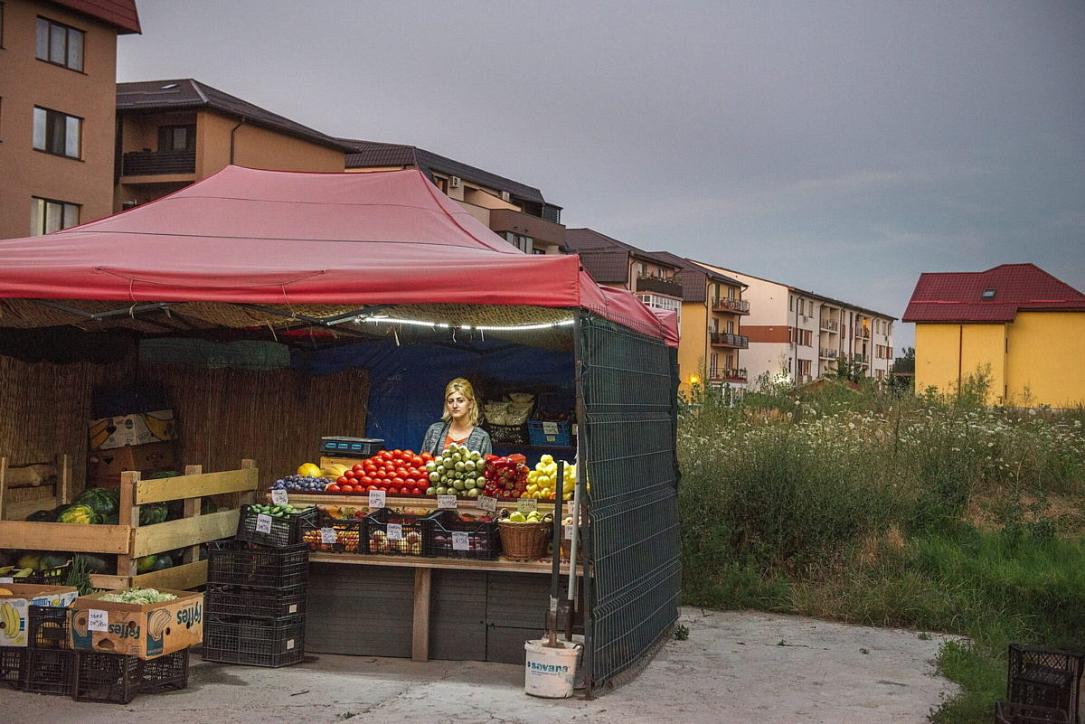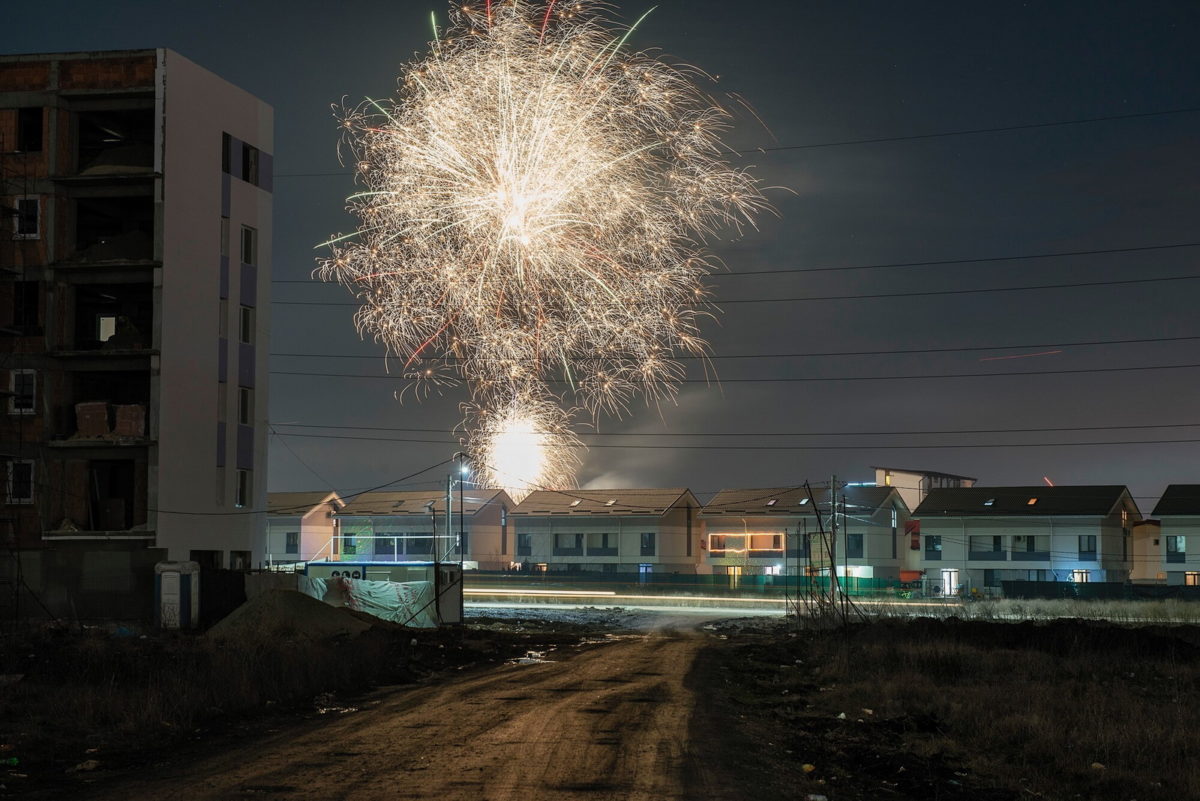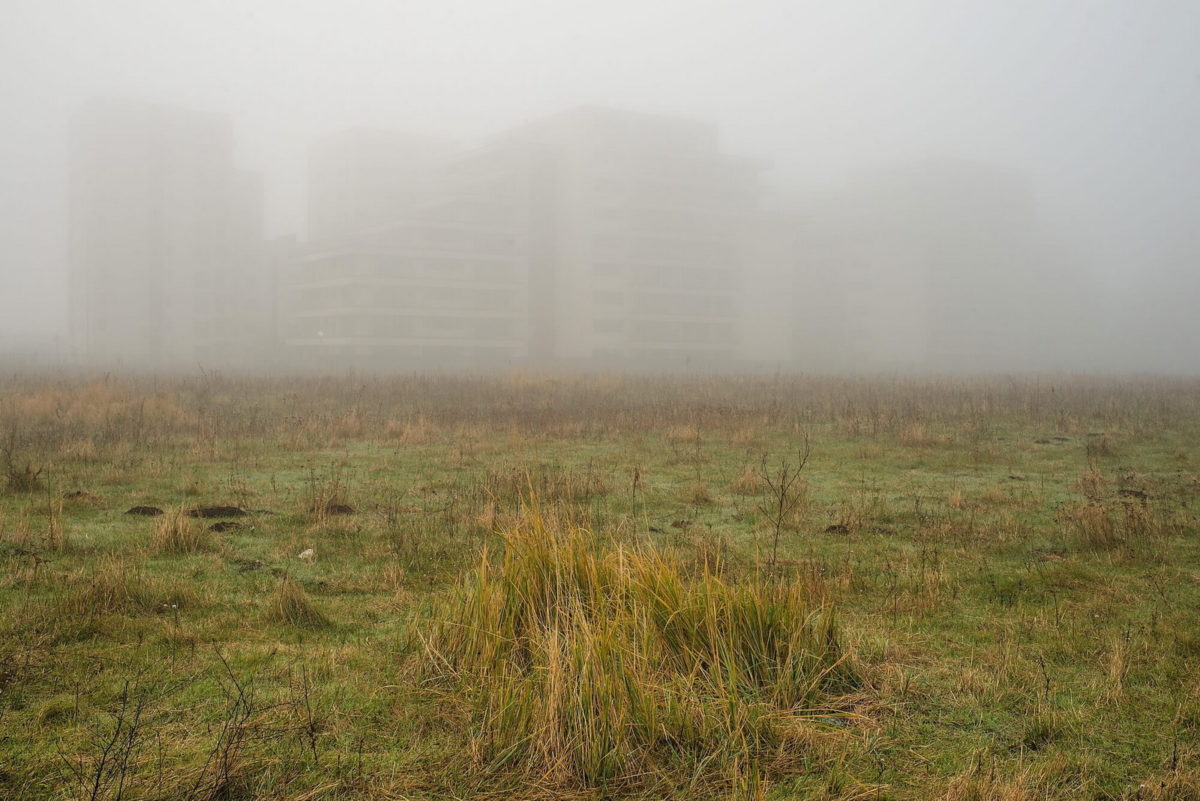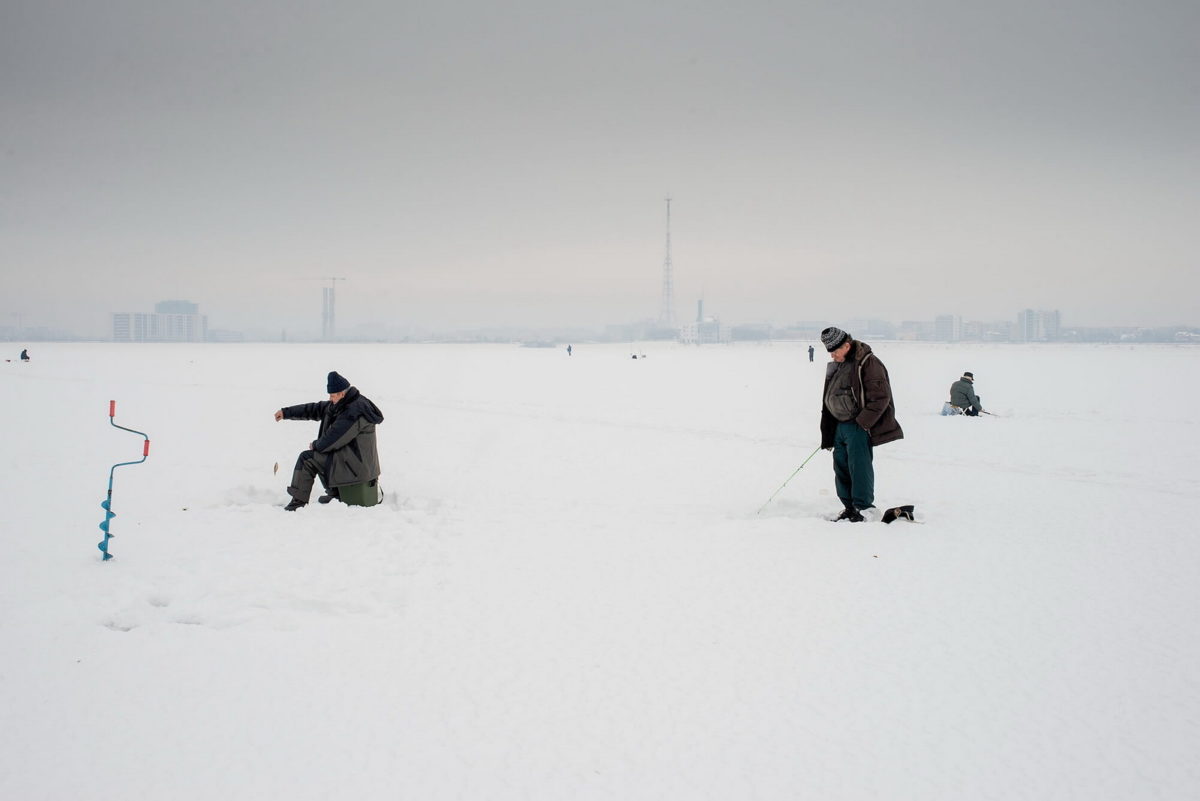Discovering Bucharest’s newly emerged suburbia

A photographer - journalist duo uncovers life in the Romanian capital city's newly emerged suburbia, where new apartment blocks or office buildings can co-exist with wild animals or herds of sheep and goats.
Romanian photographer Petruț Călinescu and journalist Ioana Călinescu documented Bucharest’s suburbia for two years. They discovered that people’s expectations seldom matched the reality. Newly-built oasis-like residential compounds were totally disconnected from the city. Infrastructure was an elusive dream.
Every time Ioana and Petruț would leave Bucharest during summer to visit Petruț’s parents in Constanta, they would drive past a residential complex on the outskirts of Bucharest. It looked to them like a working colony right in the middle of a field. Although intriguing, they were always in a hurry and didn’t stop. But the image of that isolated group of blocks was somehow daunting, so the couple decided to make a detour.
Behind the residential complex they discovered a sheepfold, with several hundred sheep. For them, it became the emblematic image of Bucharest’s chaotic real estate development on the outskirts. They decided that they’d start documenting and photographing the suburbs of Bucharest, periferia. Petruț bought a map of Bucharest, a mayor’s map, as he calls it laughing, and pinned all the areas that were worth seeing. Two years later, Petruț and Ioana have published the project’s newspaper.
I first met Petrut and Ioana in 2012, when they were working on a story about the Romanian immigration. The result was a photography book called Pride and Concrete. It told the story of men and women from Northern Romania who went to work abroad in search of a better life. They thought that they would leave only for a short while, but have never actually returned. People invested their money in Romania in huge houses they didn’t get to live in. These houses became the symbols of wealth and economic security, symbols of pride. Their symbolic function was more important than their practicality.
 New Year's fireworks at a new residential complex in Militari on the periphery of Bucharest.
New Year's fireworks at a new residential complex in Militari on the periphery of Bucharest.Petrut and Ioana’s recent story about the outskirts of Bucharest is also a story about pride. The middle-class pride. The pride of people who managed to escape the old apartment blocks, often seen as symbols of Communism, and move to new communities. It is also a story of shame because some of these people didn’t find the pretty new life they were expecting. The utopia felt more like a dream gone bad that they had to live in, marked by traffic jams and lack of adequate infrastructure. But a dream they had to protect in front of others to avoid shame.
In December last year, I sat down with Ioana and Petruț for an interview to learn more about Bucharest’s outskirts.
***
What was your initial approach to this story? How has it evolved over time?
Ioana: In the beginning, we were planning to show several angles of the suburbs beside the real estate angle, which is absolutely obvious. I was imagining that we’d be able to document hobbies and activities that take place on the outskirts, things that you don’t normally associate with the suburbs. (...) like people growing pigeons for competitions, people going fishing. We wanted to find ad-hoc parties organized in forests. But things didn’t go as planned. The suburbia story turned out to be mainly about its chaotic real development.
What were your fears in the beginning?
Petruț: I had many moments when I thought that nothing would come out of this project. You go there and you often don’t find anything interesting. But this thing about what’s interesting is actually relative. You don’t find it like mushrooms in the woods. Things are not there expecting you to see them. You have to train your mind somehow and if you are not able to do this every day you can easily be distracted, even by the traffic. Apart from that, everyone is suspicious and anxious when they see you with a camera. What are you doing? Who sent you?
Why are they suspicious?
Petruț: Shepherds are suspicious that their employer sent you to photograph them. On construction sites, everyone has something to hide. Also, media are often mistrusted. I try to explain that I don’t represent the conventional media. I don’t work for a newspaper or for a TV station. But in general, media are not well seen because they often attack people.
How are the suburbs represented in mainstream media?
Petruț: There’s not so much about it. Sometimes developers pay newspapers and magazines to represent the outskirts as an oasis of peace.
Why do people choose to move to the outskirts?
Petrut: It's very cheap, it's cheaper than the city center.
Ioana: It's affordable for people with average incomes. (...) We talked to the owners of a house built in the middle of a field. A young family with a child, who’ve always dreamed to live in a house. They had initially bought an apartment in a compound in Eastern Bucharest and later built the house in the same area. (...) I was curious if they were worried about schools, kindergartens. But they were certain that there would be a school, a kindergarten, a park someday in the future. They really believed that these things would one day exist.
 A residential complex, barely visible on a misty morning. The new apartment block has been constructed for an upper-middle-class clientele in the Pipera neighborhood in northern Bucharest.
A residential complex, barely visible on a misty morning. The new apartment block has been constructed for an upper-middle-class clientele in the Pipera neighborhood in northern Bucharest.Isn’t it also a sort of class segregation? People wanting to withdraw from working-class neighborhoods?
Petruț: Maybe in gated communities. These are advertised as places where everybody is happy and lives in nice homes, just like in a detergent commercial. I suppose it’s the dream of a Western lifestyle. (...) In toothpaste and detergent commercials all Romanians seem to be living in a two-storey house, with a golden retriever playing on the lawn.
Ioana: They’ve managed to create this kind of reality in a residential compound in Stefanestii de Jos, near Bucharest. It’s just like an island across the ring road.
Petruț: It looks like a mirage in the desert seen from the highway, like an oasis in the middle of weeds.
Ioana: From the inside, you don’t see the weeds.
Petruț: Many developers managed to build oases, but these are disconnected from the city. The infrastructure doesn’t exist. It’s an hour and a half drive to get there. It drives you nuts.
Ioana: We’ve put together a list with the names of all these residential compounds to show the aspiration towards a Western lifestyle. Barcelona Residence Rahova, Dream Life Popesti Leordeni. They all have English names.
Petruț: Or the Scandinavian German village.
Maybe it’s a normal process. It takes time to build infrastructure.
Ioana: This is what they all hope, but it’s also important when it actually happens.
Petruț: It should happen in this life, not in the afterlife. That’s how these roads are.
Citizens have become more active, including those in the suburbs. Was it a reaction to problems?
Ioana: I talked to one of the leaders of a citizen group in the Prelungirea Ghencea suburbs area. It’s a super active woman. When she moved to the Prelungirea Ghencea, her daughter was seven months old. Now she’s going to high school. The woman waited for a while for things to happen. 15 years have gone by. Nothing happened. They don’t have streets, infrastructure. People have started reacting, becoming more active. All this has built up. It’s like a powder keg.
Do the citizens’ actions have any result?
Ioana: They do have an effect. Although not right away. But people go to town hall meetings. They take part in debates. They propose projects. They even have a lawyer in the Prelungirea Ghencea civic group. It’s easy to fool people that are not well prepared, but much more difficult to do the same with people that are informed.
As these new residential compounds are emerging, an old world is disappearing. What is the world that is dying?
Petruț: The rural world, the sheepfolds. In 1989, there were tens of thousands around Bucharest, now there’re very few left. (...) Those who moved to Bucharest in the ‘60s and ‘70s were people who had previously lived in villages. They kept their old habits when they moved to apartment blocks. Some had hens in their balcony, some cared for little gardens near the apartment blocks. People who now buy apartment blocks are full-time employees in multinational companies. They sometimes make a barbecue. That’s all. It’s a new generation. Nature has a new meaning for them.
 People ice fishing on the frozen surface of Lacul Morii, a large artificial lake built during the communist-era in the 1980s to protect the city against floods.
People ice fishing on the frozen surface of Lacul Morii, a large artificial lake built during the communist-era in the 1980s to protect the city against floods.I read in your posts that a lot of people living in the suburbs talk about the wild nature. One woman was proudly saying that not many people get the chance to see a fox on their way to work.
Ioana: Yes, a lot of people living in the suburbs argue that they live there because they get to see wild animals.
Petruț: A man living in one of these compounds told us: Let’s not fool ourselves. The main reason why we move here are the low prices. We later added a new layer to the story. It’s not about the price, but about the fox.
Ioana: You settle down and then you try to convince yourself that your life is cool. (...) I remember a quote from a woman who moved to such a compound. “When I first saw field rabbits I thought they were kangaroos. Do you know how big the fields rabbits are? You can easily say they’re kangaroos.”
Interview by Diana Mesesan, features writer, editor@romania-insider.com
Editor’s note: you can find the names of the residential compounds on the project website PeriferiaB.ro
(photos courtesy of Petrut Calinescu/periferiaB)















